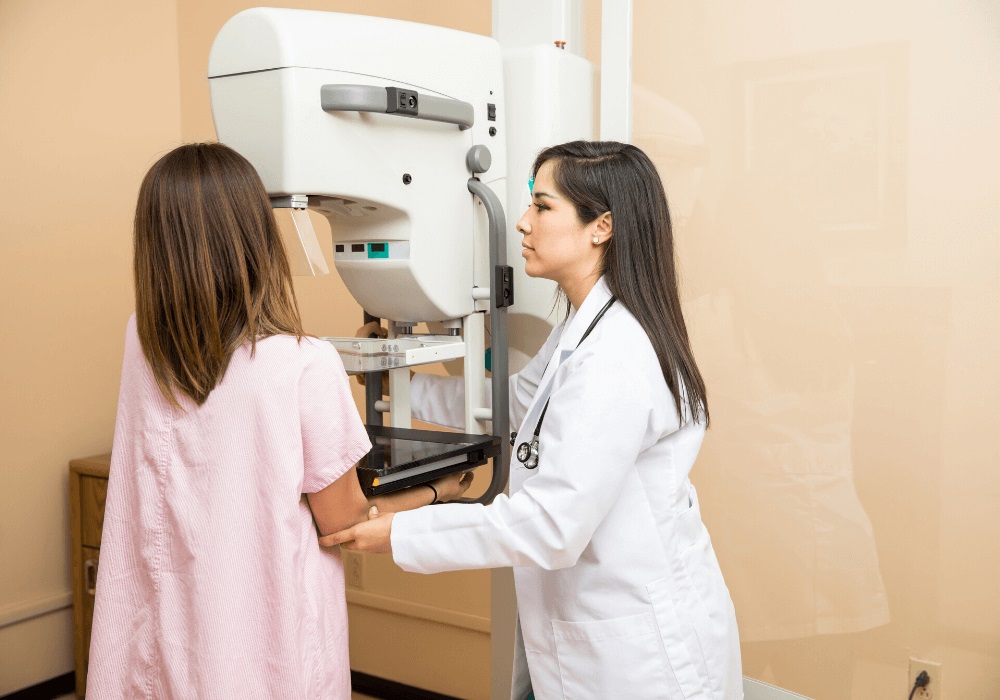A mammogram is an x-ray picture of the breast that can be used not only to detect breast cancer in women that are showing no signs or symptoms of the disease but also to check for breast cancer in women after a lump or other sign has been found. There are two different types of mammograms: screening and diagnostic.
What is the difference between screening and diagnostic mammograms?
A screening mammogram is done as a preventative measure in women who have not displayed any signs or symptoms of breast cancer because the x-ray images allow you to detect tumors that a physical screening may not.
A diagnostic mammogram is used to check for breast cancer after a lump or other sign of breast cancer has been detected. Just like we mentioned in our Breast Cancer Awareness blog post, there are many other signs of breast cancer besides finding a lump. Some of these signs may include breast pain, thickening of the skin of the breast, nipple discharge, or changes in the size, shape, or appearance of your breasts. These signs can, however, also be related to benign conditions which is why a diagnostic mammogram is important to further evaluate changes that may have been found during a screening mammogram.
Both types of mammograms use the same machine. The major differences between the two are (1) the amount of radiation you will be exposed to is higher in a diagnostic mammogram because more x-ray images are needed to view the breast from multiple angles, and (2) diagnostic mammograms take longer to obtain than screening mammograms.
What are the benefits of screening mammograms?
Early detection of breast cancer with screening mammography means that treatment can be started earlier, potentially before it can spread. This vastly increases the possibility of overcoming the disease. But we can’t talk about the benefits of screening mammograms without also talking about the risks that can come with them.
What are the potential hazards of mammograms?
Radiation exposure
Mammograms require radiation and, although it is in very small doses and results in low exposure, repeated x-rays have the potential to cause cancer. The benefits of mammography do almost always outweigh the potential harm from radiation exposure, however, you should speak with your health care provider about the need for continued x-rays. You should also be sure to disclose your potential of being pregnant with your health care provider and x-ray technician as radiation can be extremely harmful to a growing fetus.
False-positive results
A false-positive is when a radiologist sees an abnormality that could be a positive on an x-ray picture but there is no cancer present in reality. All mammograms that do find abnormalities should be followed up with additional testing to determine whether or not cancer is truly present.
False-positive results are most common among younger women, women with dense breasts, women with a family history of breast cancer, women who have had previous breast biopsies, and women who are taking estrogen.
False-positive mammograms can lead to anxiety and emotional and physical distress and the additional testing required to determine the presence or absence of cancer can be costly, time-consuming, and physically uncomfortable.
False-negative results
A negative result in cancer screening means no abnormality is present. A false-negative result gives the impression that the mammogram is normal despite the fact that breast cancer is present. This occurs most frequently among women who have high breast density and younger women because as women grow older, their breasts become more fatty which makes false-negative results less likely.
A false-negative result can give a false sense of security and can delay treatment.
I have breast implants. What can I do about screening mammograms?
While implants can hide some breast tissue and therefore make it difficult for a radiologist to detect an abnormality in the mammogram images, women with breast implants should still get regular mammograms. If you have gotten implants as a result of a mastectomy, ask your doctor whether or not they recommend a mammogram of the reconstructed breast.
In either case, it is important that you let the mammography facility know that you have breast implants when you are scheduling your mammogram. This will let them know to take the necessary precautions to make sure that as much breast tissue can be seen on the mammogram as possible.

